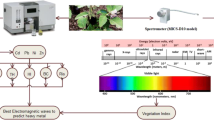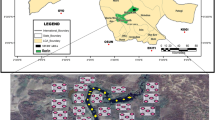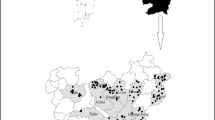Abstract
Given the tendency of heavy metals to accumulate in soil and plants, the purpose of this study was to determine the contamination levels of Cd, Ni, Pb, and Zn on peppers (leaves and fruit) grown in contaminated soils in industrial centers. For this purpose, we measured the uptake of the four heavy metals by peppers grown in the heavy metal contaminated soils throughout the four growth stages: two-leaf, growth, flowering, and fruiting, and calculated various vegetation indices to evaluate the heavy metal contamination potentials. Electromagnetic waves were also applied for analyzing the responses of the target plants to various heavy metals. Based on the relevant spectral bands identified by principal component analysis (PCA) and random search methods, a regression method was then employed to determine the most optimal spectral bands for estimating the target hazard quotient (THQ). The THQ was found to be the highest in the plants contaminated by Pb (THQ = 62) and Zn (THQ = 5.07). The results of PCA and random search indicated that the spectra at the bands of b570, b650, and b760 for Pb, b400 and b1030 for Ni, b400 and b880 for Cd, and b560, b910, and b1050 for Zn were the most optimal spectra for assessing THQ. Therefore, in future studies, instead of examining the amount of heavy metals in plants by chemical analysis in the laboratory, the responses of the plants to the electromagnetic waves in the identified bands can be readily investigated in the field based on the established correlations.

Similar content being viewed by others
Abbreviations
- BCF:
-
Bioconcentration Factors
- DVI:
-
Differential Vegetation Index
- EDI:
-
Estimated Daily Intake
- EF:
-
Estimated Frequency
- HI:
-
Hazard Index
- IPVI:
-
Infrared Percentage Vegetation Index
- NDVI:
-
Normalized Difference Vegetation Index
- OSAVI:
-
Optimized Soil-Adjusted Vegetation Index
- PCA:
-
Principal Component Analysis
- SAVI:
-
Soil-Adjusted Vegetation Index
- THQ:
-
Target Hazard Quotient
References
Adamu B, Tansey K, Ogutu B (2015). Using vegetation spectral indices to detect oil pollution in the Niger Delta. Remote Sensing Letters, 6 (2): 145–154
Al Jassir M S, Shaker A, Khaliq M A (2005). Deposition of heavy metals on green leafy vegetables sold on roadsides of Riyadh City, Saudi Arabia. Bulletin of Environmental Contamination and Toxicology, 75(5): 1020–1027
Anand R R, Cornelius M, Phang C (2007). Use of vegetation and soil in mineral exploration in areas of transported overburden, Yilgarn Craton, Western Australia, A contribution towards understanding metal transportation processes. Geochemistry: Exploration, Environment, Analysis, 7: 267–288
Arnot J A, Gobas F A (2006). A review of bioconcentration factor (BCF) and bioaccumulation factor (BAF) assessments for organic chemicals in aquatic organisms. Environmental Reviews, 14(4): 257–297
Ashfaque F, Inam A, Sahay S, Iqbal S (2016). Influence of heavy metal toxicity on plant growth, metabolism and its alleviation by phytoremediation-a promising technology, Journal of Agriculture and Ecology Research, 6(2): 1–19
Chávez P, Zorogastúa P, Chuquillanqui C, Salazar L F, Mares V, Quiroz R (2009). Assessing Potato Yellow Vein Virus (PYVV) infection using remotely sensed data. International Journal of Pest Management, 55(3): 251–256
Cho M A, Skidmore A, Corsi F, Van Wieren S E, Sobhan I (2007). Estimation of green grass/herb biomass from airborne hyperspectral imagery using spectral indices and partial least squares regression. International Journal of Applied Earth Observation and Geoinformation, 9(4): 414–424
Cozzolino D (2014). Use of infrared spectroscopy for in-field measurement and phenotyping of plant properties: instrumentation, data analysis, and examples. Applied Spectroscopy Reviews, 49(7): 564–584
Crippen R E (1990). Calculating the vegetation index faster. Remote Sensing of Environment, 34(1): 71–73
Demirak A, Yilmaz F, Levent Tuna A, Ozdemir N (2006). Heavy metals in water, sediment and tissues of Leuciscus cephalus from a stream in southwestern Turkey. Chemosphere, 63(9): 1451–1458
Eitel J U, Gessler P E, Smith A M, Robberecht R (2006). Suitability of existing and novel spectral indices to remotely detect water stress in Populus spp. Forest Ecology and Management, 229(1–3): 170–182
EPA A (1989). Risk assessment guidance for superfund. Volume I: human health evaluation manual (part a). EPA/540/1-89/002. Washington DC: USEPA
Facchinelli A, Sacchi E, Mallen L (2001). Multivariate statistical and GIS-based approach to identify heavy metal sources in soils. Environmental Pollution, 114(3): 313–324
FDA (Food and Drug Administration) (2001). Dietary reference intakes for vitamin A, vitamin K, arsenic, boron, chromium, copper, iodine, iron, manganese, molybdenum, Ni, silicon, vanadium, and Zn. Report of the Panel on Micronutrients. Washington, DC: National Academy Press, Food and Drug Administration, Dietary supplements, Center for Food Safety and Applied Nutrition
Ferwerda J G, Skidmore A K, Mutanga O (2005). Nitrogen detection with hyperspectral normalized ratio indices across multiple plant species. International Journal of Remote Sensing, 26(18): 4083–4095
Ha H, Olson J R, Bian L, Rogerson P A (2014). Analysis of heavy metal sources in soil using kriging interpolation on principal components. Environmental Science & Technology, 48(9): 4999–5007
Haboudane D, Miller J R, Tremblay N, Zarco-Tejada P J, Dextraze L (2002). Integrated narrow-band vegetation indices for prediction of crop chlorophyll content for application to precision agriculture. Remote Sensing of Environment, 81(2–3): 416–426
Hadjimitsis D G, Papadavid G, Agapiou A, Themistocleous K, Hadjimitsis M G, Retalis A, Michaelides S, Chrysoulakis N, Toulios L, Clayton C R I (2010). Atmospheric correction for satellite remotely sensed data intended for agricultural applications: impact on vegetation indices. Natural Hazards and Earth System Sciences, 10 (1): 89–95
Hamzeh S, Mokarram M, Haratian A, Bartholomeus H, Ligtenberg A, Bregt A K (2016). Feature selection as a time and cost-saving approach for land suitability classification (case study of Shavur Plain, Iran). Agriculture, 6(4): 52
Jimoh W L O, Mohammed MI (2012). Assessment of cadmium and lead in soil and tomatoes grown in irrigated farmland of the Kaduna Metropolis Nigeria. Research Journal of Environmental and Earth Sciences, 4(1): 55–59
Jordanova N V, Jordanova D V, Veneva L, Yorova K, Petrovsky E (2003). Magnetic response of soils and vegetation to heavy metal pollution a case study. Environmental Science & Technology, 37(19): 4417–4424
Kabatapendias A, Pendias H K (2011). Trace Elements in Soils and Plants. Boca Raton, FL, USA: CRC Press, 951–974
Kemper T, Sommer S (2002). Estimate of heavy metal contamination in soils after a mining accident using reflectance spectroscopy. Environmental Science & Technology, 36(12): 2742–2747
Kooistra L, Salas E A L, Clevers J G P W, Wehrens R, Leuven R S EW, Nienhuis P H, Buydens L M C (2004). Exploring field vegetation reflectance as an indicator of soil contamination in river floodplains. Environmental Pollution, 127(2): 281–290
Li J, Ma Y B, Hu H W, Wang J T, Liu Y R, He J Z (2015). Field-based evidence for consistent responses of bacterial communities to copper contamination in two contrasting agricultural soils. Frontiers in microbiology, 6: 1–31
Liu K H, Liang X L, Li C M, Yu F M, Li Y (2020). Nutrient status and pollution levels in five areas around a manganese mine in southern China. Frontiers of Environmental Science & Engineering, 14(6): 100 https://doi.org/10.1007/s11783-020-1279-0
Liu P, Zhao H, Wang L, Liu Z, Wei J, Wang Y, Jiang L, Dong L, Zhang Y (2011). Analysis of heavy metal sources for vegetable soils from Shandong Province, China. Agricultural Sciences in China, 10(1): 109–119
Llobet J M, Falco G, Casas C, Teixido A, Domingo J L (2003). Concentrations of arsenic, cadmium, mercury, and lead in common foods and estimated daily intake by children, adolescents, adults, and seniors of Catalonia, Spain. Journal of Agricultural and Food Chemistry, 51(3): 838–842
Moore P D, Chapman S B (1986). Methods in Plant Ecology. London: Blackwell Scientific Publication
Mosleh M K, Hassan Q K, Chowdhury E H (2015). Application of remote sensors in mapping rice area and forecasting its production: a review. Sensors (Basel), 15(1): 769–791
Muchuweti M, Birkett J W, Chinyanga E, Zvauya R, Scrimshaw M D, Lester J N (2006). Heavy metal content of vegetables irrigated with mixtures of wastewater and sewage sludge in Zimbabwe: implications for human health. Agriculture, Ecosystems & Environment, 112(1): 41–48
Noori R, Karbassi A R, Moghaddamnia A, Han D, Zokaei-Ashtiani M H, Farokhnia A, Gousheh M G (2011). Assessment of input variables determination on the SVM model performance using PCA, Gamma test, and forward selection techniques for monthly stream flow prediction. Journal of Hydrology (Amsterdam), 401(3–4): 177–189
Orisakwe O E, Nduka J K, Amadi C N, Dike D, Obialor O O (2012). Evaluation of potential dietary toxicity of heavy metals of vegetables. Journal of Environmental & Analytical Toxicology, 2(03): 1–4
Pellecchia A, Fernández T V, Franzitta G, Bertocci I (2020). Recovery ability of lowshore sessile assemblages in a highly contaminated post-industrial area. Marine Environmental Research, 153: 10–26
Peñuelas J, Filella I (1998). Visible and near-infrared reflectance techniques for diagnosing plant physiological status. Trends in Plant Science, 3(4): 151–156
Pickup G, Chewings V H, Nelson D J (1993). Estimating changes in vegetation cover over time in arid rangelands using Landsat MSS data. Remote Sensing of Environment, 43(3): 243–263
Richardson A J, Everitt J H (1992). Using spectral vegetation indices to estimate rangeland productivity. Geocarto International, 7(1): 63–69
Salgueiro M J, Zubillaga M B, Lysionek A E, Sarabia M I, Caro R A, De Paoli T, Hager A, Ettlin E, Weill R, Boccio J R (2000). Bioavailability, biodistribution, and toxicity of BioZn-AAS: A new zinc source. Comparative studies in rats. Nutrition, 16(9): 762–766
Shukla S R, Pai R S (2005). Comparison of Pb (II) uptake by coir and dye loaded coir fibres in a fixed bed column. Journal of Hazardous Materials, 125(1–3): 147–153
Singh V, Garg A N (2006). Availability of essential trace elements in Indian cereals, vegetables and spices using INAA and the contribution of spices to daily dietary intake. Food Chemistry, 94(1): 81–89
Slonecker E T (2011). Analysis of the effects of heavy metals on vegetation hyperspectral reflectance properties. In: Thenkabail A, Lyon P S, Huete J G, Eds. Hyperspectral Remote Sensing of Vegetation. Boca Raton: CRC Press, 561–578
Slonecker T, Haack B, Price S (2009). Spectroscopic analysis of arsenic uptake in Pteris ferns. Remote Sensing, 1(4): 644–675
Song B, Lei M, Chen T, Zheng Y, Xie Y, Li X, Gao D (2009). Assessing the health risk of heavy metals in vegetables to the general population in Beijing, China. Journal of Environmental Sciences-China, 21(12): 1702–1709
Sridhar B B M, Han F X, Diehl S V, Monts D L, Su Y (2007). Effects of Zn and Cd accumulation on structural and physiological characteristics of barley plants. Brazilian Journal of Plant Physiology, 19(1): 15–22
Sridhar B M, Vincent R K, Roberts S J, Czajkowski K (2011). Remote sensing of soybean stress as an indicator of chemical concentration of biosolid amended surface soils. International Journal of Applied Earth Observation and Geoinformation, 13(4): 676–681
Tang W Z, Sun L, Shu L M, Wang C (2020). Evaluating heavy metal contamination of riverine sediment cores in different land-use areas. Frontiers of Environmental Science & Engineering, 2020, 14(6): 104
Thenkabail PS, Gamage MSDN (2004). The use of remote sensing data for drought assessment and monitoring in Southwest Asia. Research Report, 85: 1–34
USEPA (US Environmental Protection Agency) (2000). Risk-Based Concentration Table. Washington, DC, USA: Office of Health and Environmental Assessment
USEPA (US Environmental Protection Agency) (2011). Risk - based concentration table environmental protection agency. Washington DC: Philadelphia PA
Usman K, Al-Ghouti M A, Abu-Dieyeh M H (2019). The assessment of cadmium, chromium, copper, and nickel tolerance and bioaccumulation by shrub plant Tetraena qataranse. Scientific Reports, 9(1): 1–11
Wang X, Sato T, Xing B, Tao S (2005). Health risks of heavy metals to the general public in Tianjin, China via consumption of vegetables and fish. Science of the Total Environment, 350(1–3): 28–37
Yang H, Wang F, Yu J, Huang K, Zhang H, Fu Z (2020). An improved weighted index for the assessment of heavy metal pollution in soils in Zhejiang, China. Environmental Research, 2020: 110246
Yang Y, Zhang F S, Li H F, Jiang R F (2009). Accumulation of cadmium in the edible parts of six vegetable species grown in Cd-contaminated soils. Journal of Environmental Management, 90(2): 1117–1122
Zheng N, Wang Q, Zhang X, Zheng D, Zhang Z, Zhang S (2007). Population health risk due to dietary intake of heavy metals in the industrial area of Huludao city, China. Science of the Total Environment, 387(1–3): 96–104
Acknowledgements
The authors would like to acknowledge the Shiraz University for funding this research (238726-141).
Author information
Authors and Affiliations
Corresponding authors
Additional information
Highlights
• There was significant absorption of heavy metals by the pepper in contaminated soils.
• The target hazard quotient (THQ) indices followed the order of Pb>Zn>>Cd ≈ Ni.
• Relationships exist between contaminated plants and electromagnetic wave.
• PCA and random search can select the main spectra and predict THQ for each element.
Supporting Information
Rights and permissions
About this article
Cite this article
Mokarram, M., Pourghasemi, H.R. & Zhang, H. Predicting non-carcinogenic hazard quotients of heavy metals in pepper (Capsicum annum L.) utilizing electromagnetic waves. Front. Environ. Sci. Eng. 14, 114 (2020). https://doi.org/10.1007/s11783-020-1331-0
Received:
Revised:
Accepted:
Published:
DOI: https://doi.org/10.1007/s11783-020-1331-0




